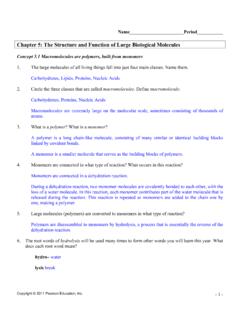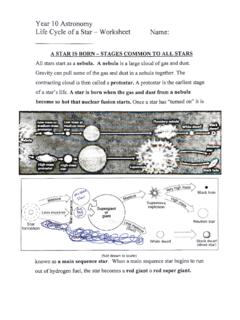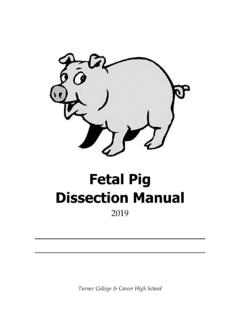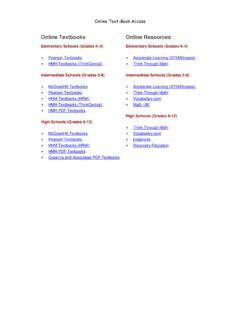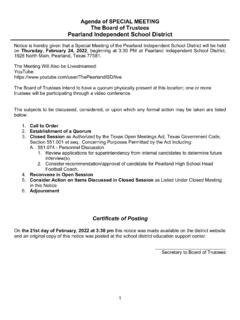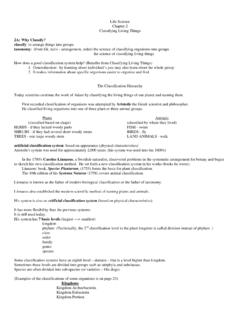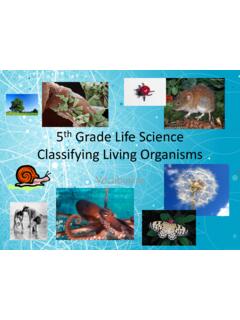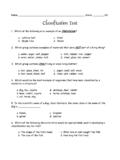Transcription of Classification of Living Things - Pearland High School
1 Classification of Living ThingsTacitusbellusPopulus tremuloidesQuaking Aspen Finding Order in Diversity *To study the diversity of life, biologists use a Classification system to name organisms and group them in a logical manner. All Scientist will be using the same name Taxonomyis the branch of biology that groups and names organisms based on studies of their different characteristics. Biologists who study taxonomy are called taxonomists. Classification systems change with expanding von Linnaeus(1707-1778) Carolus Linnaeus Swedish botanist Developed Binomial Nomenclature **All Scientist will be using the same scientific name.
2 Two-word naming system Genus Noun, Capitalized, Underlined or Italicized Species Descriptive, Lower Case, Underlined or Italicized Each species is assigned a two-partscientific name Ex. Ursus arctosSystem of Classification Linnaeus s hierarchical system of Classification includes eight levels (from largestto smallest) Grizzly Bear (common name) DomainEukarya KingdomAnimalia PhylumChordata ClassMammalia OrderCarnivora FamilyUrsidae GenusUrsus SpeciesarctosEach of the levels is called a TAXONU rsus arctos(scientific name)System of Classification Taxonomic categories, an acronym.
3 DomainDear KingdomKing PhylumPhillip ClassCame OrderOver FamilyFor GenusGood SpeciesSoupKPCOFGSUse the table to complete the worksheetWorksheet Phylogeny evolutionary relationships among organisms Evolutionary Classification strategy of grouping organisms together based on their evolutionary history Fossil record Comparative homologies Comparative sequencing of DNA/RNA among organisms Molecular clocksEvolutionary ClassificationMolecular ClockAllows scientist to compare DNA sequences from two species to estimate how long it has been since they diverged from a common ancestorTaxonomic DiagramsPhylogenetic Tree.
4 Represent hypothesized evolutionary relationshipsMammalsTurtlesLizards and SnakesCrocodilesBirdsLooks like aBranch on a treeAttempt to trace the process of evolution by focusing on shared featuresCladogramTaxonomic DiagramsWhich organism is the outgroupMammalsWhich 2 organism are more closely relatedCrocodiles and birdsRefer to page 496 to 497 Group practiceIndividual practiceThe more specific you get, the more options you have.(3)(6)(32)(90)(493)(5,404)(94,240)( 953,434)Dichotomous Keys Identify Organisms Dichotomous keys contain pairsof contrasting descriptions.
5 After each description, the key directs the user to another pair of descriptions or identifies the : ) Is the leaf simple? Go to 2b) Is the leaf compound? Go to ) Are margins of the leaf jagged? Go to 4b) Are margins of the leaf smooth? Go to 5 WorksheetClassification of Living ThingsDomains (Notice the domains on the chart) Most inclusivecategory Larger than a kingdom There are 3 Eukarya includes the kingdoms Protists, Fungi, Plants& Animals Bacteria corresponds to the kingdom Eubacteria Archaea corresponds to the kingdom ArchaebacteriaSlides 17-23 Is more specific with the classificationKingdoms (Eubacteria and Archaebacteria)
6 Prokaryotes, with or without peptidoglycan in cell walls Protista Eukaryotes, diverse, not fungi, plants, or animals Fungi Eukaryotes, multicellular (except yeasts), heterotrophic, chitin in cell walls Plantae Eukaryotes, multicellular, autotrophic, cell wall containing cellulose Animalia Eukaryotes, multicellular, heterotrophic, no cell wallKingdom -Eubacteria Common name: Bacteria Unicellular prokaryotes Peptidogylcanin cell wall Ecologically diverse Basic shapes are cocci, bacilli, spirilla Reproduce both sexuallyand asexuallyBacillus anthracis(spores can live in soil for years)Streptococcus mutans(can cause endocarditis and dental caries)Kingdom -Archaebacteria Cell wall does not contain peptidogylcan Cell membrane contains unusual lipids not found in other organisms Live in extremeenvironments (devoid of oxygen).
7 Volcanic hot springs brine pools black organic mudArchaeafirst detected in extreme environments, such as volcanic hot Protista A Classification problem consists of organisms that cannotbe classified as animals, plants, or fungi Most unicellular, some colonial and some multicellular Autotrophicand heterotrophic Some move with flagella, pseudopods or cilia Animal-like, plant-like and fungus-like groups Reproduce by mitosisand meiosisEntamoeba histolyticaKingdom Fungi Most feed on dead, decaying organic matterby secreting digestive enzymes into their food source then absorbing it into their bodies Cell walls of CHITIN Most multicellular.
8 Some unicellular HeterotrophicBoletus zelleri(Edible, but often infected with fly larvae)Epidermophyton floccosum(one of the causes of athlete's foot) Kingdom Plantae Multicellular Nonmotile cannot move from place to place Cell wall with cellulose Mostly photosynthetic autotrophsSunflowers in Fargo, North DakotaGinkgo bilobaGinkgos are often very long-lived. Some specimens are thought to be more than 3,500 years Animalia Multicellular Heterotrophic No cell walls or chloroplasts Incredibly diversityHymenoptera Dialictus zephrumTxodes scapularisDeer tickHierarchical Systemof ClassificationDomainKingdomPhylumClassOr derFamilyGenusSpecies From general to more specificHow Many Kingdoms?
9 6 Kingdoms Activity: What am I?Ecotherms vs Endotherms Ectotherm,Any so-called cold-bloodedanimal; that is, any animal whose regulation of body temperature depends on external sources, such as sunlight or a heated rock surface. The ectothermsinclude the fishes, amphibians, reptiles, and invertebrates. Endotherm,so-called warm-bloodedanimals; that is, those that maintain a constant body temperature independent of the environment. The endotherms primarily include the birdsand mammals.
